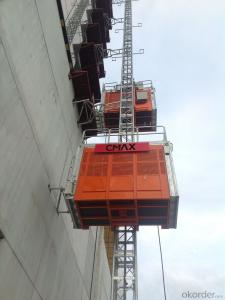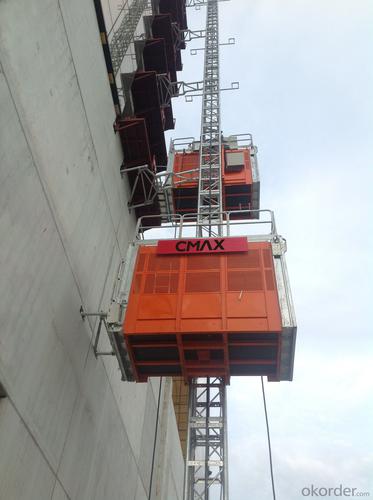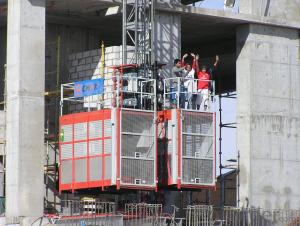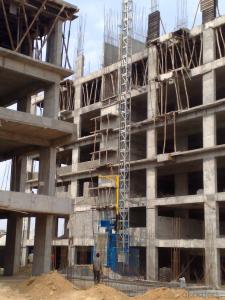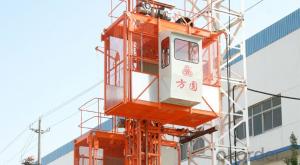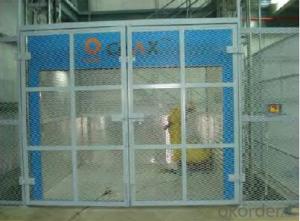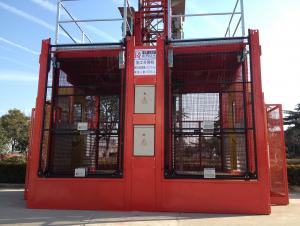Building Lifting Hoist with Double Cage SC200/200China Cheap Price Site
- Loading Port:
- Shanghai
- Payment Terms:
- TT OR LC
- Min Order Qty:
- 1 unit
- Supply Capability:
- 1000 unit/month
OKorder Service Pledge
OKorder Financial Service
You Might Also Like
Specification
Construction Building Lifting Hoist with Double Cage SC200/200China Cheap Price Site
We are special supplier of building hoist in China, our building hoist have been Widely exported to all over the world and won good reputation, whose payload capacity is as much as 10000kg, lifting speed can reach up to 96m/min, and the erection height reaches up to 550m., our products have been widely used for transportation for both men and cargo in field of general buildings, but also industry, electric power, mining well, oil, chemical industry etc.
SC270TD, SC270/270TD building hoist:
1). Each cage load capacity: 2700kg
2). Lifting speed: 36m/min, or 0∼ 63m/min, or 0∼ 96m/min
3). Mast section: Paint or hot dipping zinc
4). Cage: Single cage or twin cage
5). Recommended cage inner dimension(LxWxH)(m): 2.5x1.3 x2.5; 3.0x1.3x2.5; 3.2x1.5x2.5; 3.6x1.5x2.5; 3.8x1.5x2.5; 4.0x1.5x2.5; 4.2x1.5x2.5, cage dimension is according to requirement of customer and special project.
6). Motor and reducing device: Made in China, can be SEW Germany according to requirements.
7). Counterweight: With counterweight or without counterweight
8). The colors of cage: Yellow, or red, or blue
9). Other each cage load capacity for your to choose: 1000kg, 2000kg, 2700kg, or 3200kg
| Type | Payload kg | Lifting speed m/min | Motor power kW | Inverter power kW | Counter Weight kg | ||
| Low speed | Single cage no counterweight | SC200GD | 2000 | 0~46 | 3×15 | 45 | 0 |
| SC270GD | 2700 | 0~46 | 3×18.5 | 55 | 0 | ||
| SC320GD | 3200 | 0~46 | 3×22 | 75 | 0 | ||
| Twin cage no counterweight | SC200/200GD | 2×2000 | 0~46 | 2×3×15 | 2×45 | 0 | |
| SC270/270GD | 2×2700 | 0~46 | 2×3×18.5 | 2×55 | 0 | ||
| SC320/320GD | 2×3200 | 0~46 | 2×3×22 | 2×75 | 0 | ||
| Middle speed | Single cage no counterweight | SC120GZ | 1200 | 0~63 | 3×15 | 45 | 0 |
| SC200GZ | 2000 | 0~63 | 3×18.5 | 55 | 0 | ||
| Single cage with counterweight | SCD200GZ | 2000 | 0~63 | 2×15 | 30 | 2000 | |
| SCD270GZ | 2700 | 0~63 | 2×18.5 | 37 | 2000 | ||
| SCD320GZ | 3200 | 0~63 | 3×15 | 45 | 2000 | ||
| Twin cage no counterweight | SC120/120GZ | 2×1200 | 0~63 | 2×3×15 | 2×45 | 0 | |
| SC200/200GZ | 2×2000 | 0~63 | 2×3×18.5 | 2×55 | 0 | ||
| Twin cage with counterweight | SCD200/200GZ | 2×2000 | 0~63 | 2×15 | 2×30 | 2×2000 | |
| SCD270/270GZ | 2×2700 | 0~63 | 2×18.5 | 2×37 | 2×2000 | ||
| SCD320/320GZ | 2×3200 | 0~63 | 2×3×15 | 2×45 | 2×2000 | ||
| High speed | Single cage no counterweight | SC100GS | 1000 | 0~96 | 3×22 | 75 | 0 |
| SC120GS | 1200 | 0~96 | 3×22 | 75 | 0 | ||
| SC200G | 2000 | 0~96 | 3×22 | 90 | 0 | ||
| SC200GS | 2000 | 0~96 | 3×22 | 90 | 0 | ||
| Single cage with counterweight | SCD200G | 2000 | 0~96 | 3×15 | 45 | 2000 | |
| SCD200GS | 2000 | 0~96 | 2×22 | 45 | 2000 | ||
| SCD270G | 2700 | 0~96 | 3×18.5 | 55 | 2000 | ||
| SCD320GS | 3200 | 0~96 | 3×22 | 75 | 2000 | ||
| Twin cage no counterweight | SC100/100GS | 2×1000 | 0~96 | 2×3×22 | 2×75 | 0 | |
| SC120/120GS/ | 2×1200 | 0~96 | 2×3×22 | 2×75 | 0 | ||
| SC200/200G | 2×2000 | 0~96 | 2×3×22 | 2×90 | 0 | ||
| SC200/200GS | 2×2000 | 0~96 | 2×3×22 | 2×90 | 0 | ||
| Twin cage with counterweight | SCD200/200G | 2×2000 | 0~96 | 2×3×15 | 2×45 | 2×2000 | |
| SCD200/200GS | 2×2000 | 0~96 | 2×2×22 | 2×45 | 2×2000 | ||
| SCD270/270G | 2×2700 | 0~96 | 2×3×18.5 | 2×55 | 2×2000 | ||
| SCD320/320G | 2×3200 | 0~96 | 2×3×22 | 2×75 | 2×2000 | ||
| SCD320/320GS | 2×3200 | 0~96 | 2×3×22 | 2×75 | 2×2000 | ||
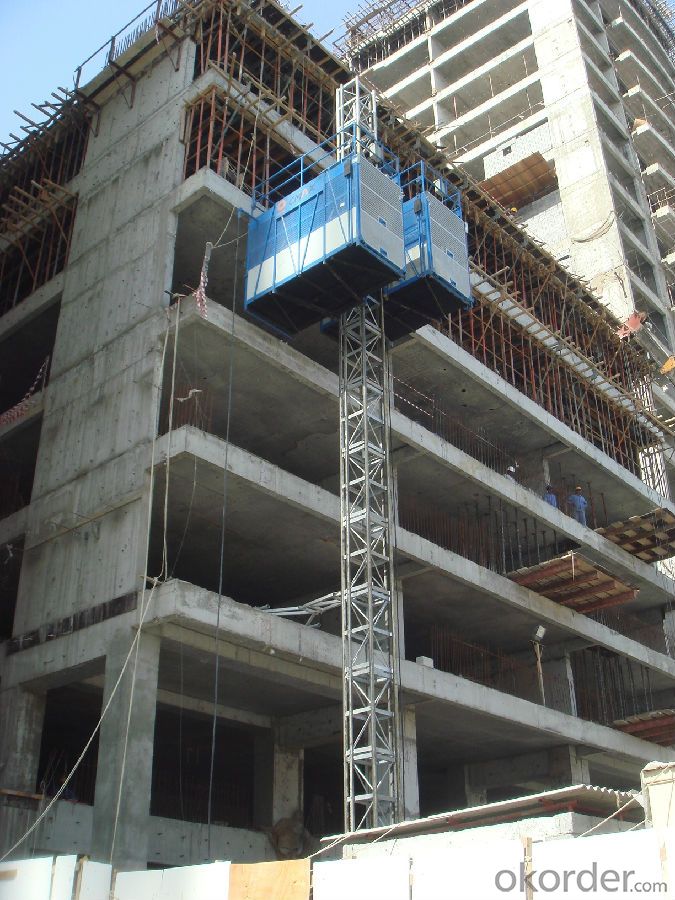
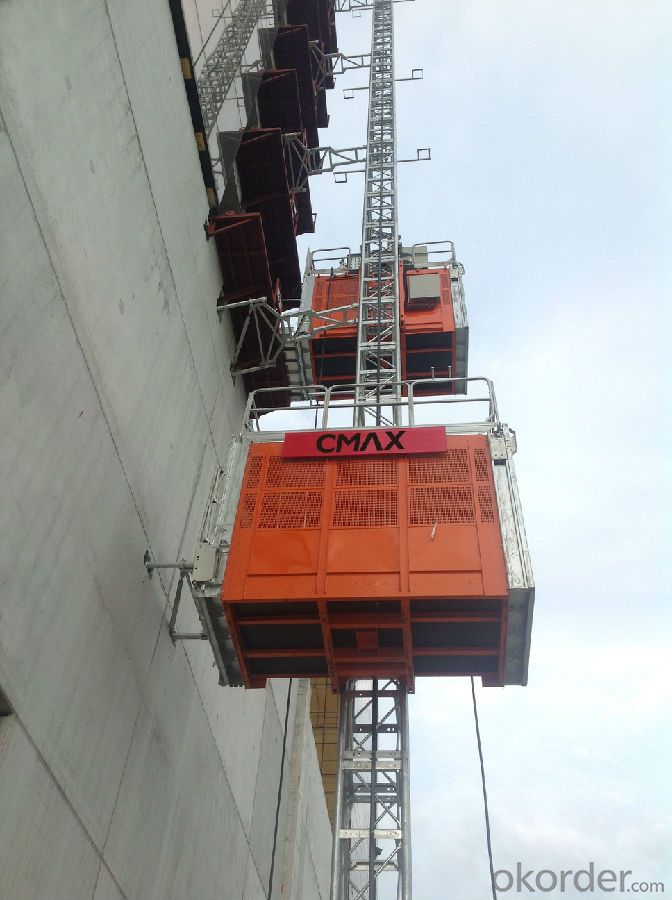
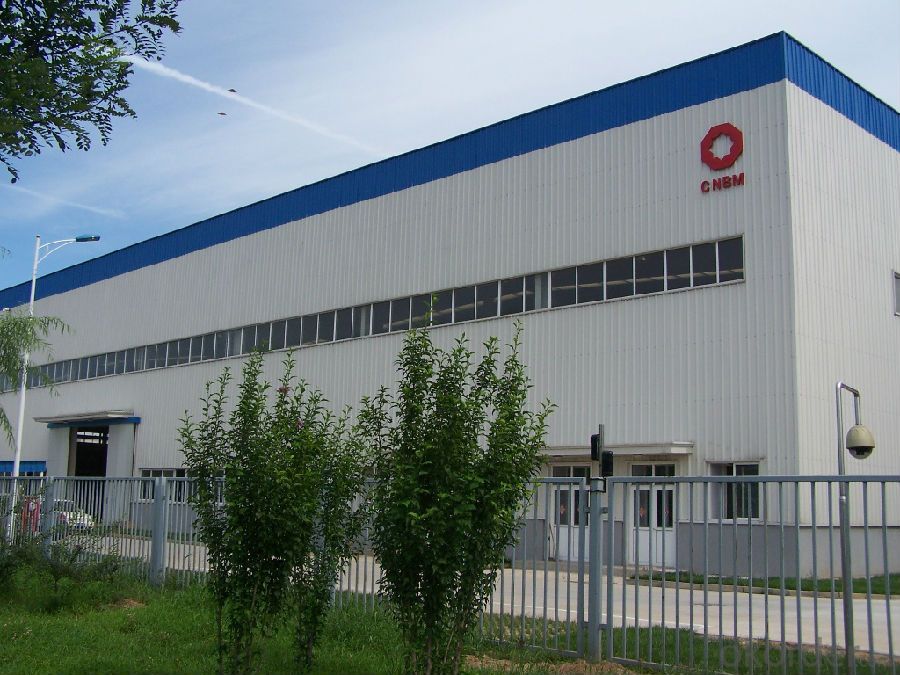
- Q: Is it safe to use a building hoist for lifting heavy objects when there is wind?
- <p>Using a building hoist in windy weather is generally not recommended due to the increased risk of accidents. Wind can cause the hoist to sway, potentially leading to loss of control and dropping of the load. Safety guidelines typically advise against hoisting operations when wind speeds exceed certain limits, often around 20-30 miles per hour (32-48 kilometers per hour). It's crucial to check local regulations and the manufacturer's guidelines for the specific hoist model to determine safe operating conditions. Always prioritize safety and ensure that all necessary precautions are taken to secure the load and the hoist in windy conditions.</p>
- Q: Is it possible to use a building hoist to lift multiple items simultaneously?
- <p>Yes, a building hoist can be used for lifting multiple objects at once, provided that the combined weight of the objects does not exceed the hoist's load capacity. It's important to ensure that the hoist is designed for such use and that safety precautions are strictly followed to prevent accidents. The objects should be secured properly to avoid any shifting during the lift, and the operation should be conducted by trained personnel to maintain safety standards.</p>
- Q: The safety officer shall be responsible for the work of the construction elevator
- (1) the use of dual-use functions of the construction elevator, the installation and removal of the professional personnel issued by the competent department of construction administration shall be undertaken by the professional personnel. The personnel who have passed the training, qualified for the examination and obtained the certificate of the post shall be operated and repaired. (2) the capacity of the concrete base culture cooperation should not be less than 150kPa, the tolerance of 10mm and the drainage facility should be allowed. The distance between the guide bracket of the elevator and the wall of the building should be suitable, and the smoothness should be stable. (3) the lifter is used to control two directions, and the vertical control is 0.05%. Each floor shall have a platform, a passage, a fence and a protective door. No obstacles can be found. (4) the elevator that is installed in a dark place, and the passage shall be illuminated and a floor display lamp and floor number; A closed barrier should be set up in the well. The elevator shall be subject to acceptance by the technical director and the relevant departments, and shall be tested by the crash and shall be used in the rear. (5) in the use of or during the use of the elevators, the manufacturer or designated unit shall conduct the debugging and maintenance and verification. The lifter should undergo a fall test every three months and the fall test should be adjusted when the fall test exceeds 1.2 m. Every time it falls, the receiver should be repaired once.
- Q: A building hoist is a piece of equipment used in construction to lift materials and personnel.
- <p>A building hoist, also known as a construction hoist or material hoist, is a temporary lifting device used in the construction industry to transport materials, equipment, and sometimes personnel vertically within a building under construction. It is essential for efficient movement of heavy and bulky items, reducing manual labor and improving safety by minimizing the need for workers to climb ladders or handle heavy loads manually. These hoists are typically installed on the exterior of the building and are used throughout the construction process until the building's permanent elevators are installed and operational.</p>
- Q: Gear rack driven
- The driver of the elevator ladder cage is driven by two or three worm gear reducers, which carry heavy lifting parts, and gravity is carried by the rack. At rest, the force point is in the meshing of the gear and rack. It is the main balance between the rewire rope and the ladder cage and the relative motion. For heavy can improve dynamic performance, a heavy on the ladder cage running more smoothly, when a fall, fall of heavy can slow down the ladder cage speed, it should be said that safety performance is better.
- Q: How many floors are built to use the construction elevator? With six floors?
- No use on the 6th floor, use longmen well frame transportation material
- Q: This question asks about frequent issues related to building hoists and seeks solutions for these problems.
- <p>Common problems with building hoists include mechanical failures, electrical issues, overloading, and safety malfunctions. Mechanical failures can be fixed by regular maintenance, lubrication, and replacement of worn parts. Electrical problems may require checking wiring, connections, and replacing faulty components. Overloading can be prevented by strictly adhering to the hoist's weight limit and using load indicators. Safety malfunctions, such as brake failure, require immediate attention and may involve replacing brake pads or overhauling the braking system. Always ensure that hoists are used according to the manufacturer's guidelines and are regularly inspected by qualified personnel to prevent accidents and ensure safe operation.</p>
- Q: This question asks for guidance on selecting appropriate lifting equipment based on specific requirements and work conditions.
- <p>To choose the right type of lifting equipment for your specific needs and work environment, consider the following: 1. Load capacity: Ensure the equipment can handle the weight of the items you need to lift. 2. Workspace: Evaluate the size and layout of your work area to determine the appropriate size and type of equipment. 3. Safety features: Look for equipment with safety features that meet your industry's standards. 4. Mobility: Consider whether you need a mobile or stationary unit. 5. Compatibility: Ensure the equipment is compatible with other tools or machinery you use. 6. Budget: Determine your budget and find equipment that offers the best value for your investment. 7. Consult with experts: Speak with equipment manufacturers or distributors to get their recommendations based on your specific needs. Always prioritize safety and efficiency when selecting lifting equipment.</p>
- Q: This question asks for a comparison of the benefits and drawbacks associated with the use of hydraulic lifting equipment.
- <p>Hydraulic lifting equipment offers several advantages, including high force generation, compact design, and precise control. It is energy-efficient and can handle heavy loads with ease. The systems are also known for their durability and low maintenance requirements. However, there are disadvantages such as sensitivity to leaks and the need for regular fluid checks. They can be complex to install and maintain, and the equipment can be costly. Additionally, hydraulic systems are sensitive to temperature changes, which can affect performance.</p>
- Q: This question is asking for a comparison between electric and hydraulic building hoists, focusing on their differences.
- <p>Electric and hydraulic building hoists differ primarily in their power source and operational mechanisms. Electric hoists use electric motors to lift and lower loads, which makes them more energy-efficient and quieter in operation. They also tend to have fewer maintenance requirements and are often easier to control with precise movements. Hydraulic hoists, on the other hand, use hydraulic pressure to move loads and are known for their ability to lift heavy loads with less effort. They are often preferred for applications requiring high lifting capacities and can be more compact. However, hydraulic hoists may require more maintenance due to the presence of seals and fluid systems, and they can be noisier than electric hoists.</p>
Send your message to us
Building Lifting Hoist with Double Cage SC200/200China Cheap Price Site
- Loading Port:
- Shanghai
- Payment Terms:
- TT OR LC
- Min Order Qty:
- 1 unit
- Supply Capability:
- 1000 unit/month
OKorder Service Pledge
OKorder Financial Service
Similar products
Hot products
Hot Searches
Related keywords
